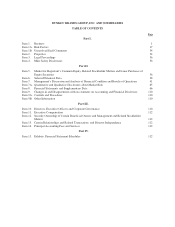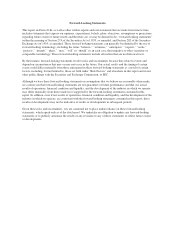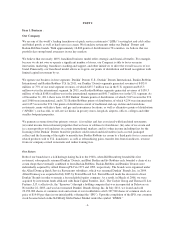Dunkin' Donuts 2011 Annual Report Download - page 15
Download and view the complete annual report
Please find page 15 of the 2011 Dunkin' Donuts annual report below. You can navigate through the pages in the report by either clicking on the pages listed below, or by using the keyword search tool below to find specific information within the annual report.
development in markets that are adjacent to our existing base, and generally move westward in a contiguous
fashion to less penetrated markets, providing for marketing and supply chain efficiencies within each new
market.
Focus on store-level economics. In recent years, we have undertaken significant initiatives to further enhance
store-level economics for our franchisees, including reducing the cash investment for new stores, increasing
beverage sales, lowering supply chain costs and implementing more efficient store management systems. We
believe these initiatives have further increased franchisee profitability. For example, we reduced the upfront
capital expenditure costs to open an end-cap restaurant with a drive-thru by approximately 24% between fiscal
2008 and fiscal 2011. Additionally, between fiscal 2008 and 2011 we believe we have facilitated approximately
$247 million in franchisee cost reductions primarily through strategic sourcing, as well as through other
initiatives, such as rationalizing the number of product offerings to reduce waste and reducing costs on branded
packaging by reducing the color mix in graphics. We recently entered into an agreement with our franchisee-
owned supply chain cooperative that provides for a three-year phase in of flat invoice pricing across the franchise
system, which, coupled with the cost reductions noted above, should lead to cost savings across the entire
franchise system. We believe that this will be one of the drivers of our contiguous development strategy, by
improving store-level economics in all markets, but particularly in newer markets where our growth is targeted.
Store-level economics have also continued to benefit from increased national marketing and from the
introduction of Dunkin’ K-Cups into our restaurants. We will continue to focus on these initiatives to further
enhance operating efficiencies.
Drive accelerated international growth of both brands
We believe there is a significant opportunity to grow our points of distribution for both brands in international
markets. Our international expansion strategy has resulted in more than 3,500 net new openings in the last
ten years.
The key elements of our future international development strategy are:
Grow in our existing core markets. Our international development strategy for both brands includes growth in
our existing core markets. For the Dunkin’ Donuts brand, we intend to focus on growth in South Korea and the
Middle East, where we currently have 857 and 229 points of distribution, respectively. For Baskin-Robbins, we
intend to focus on Japan, South Korea, and key markets in the Middle East. We intend to leverage our
operational infrastructure to grow our existing store base of 2,651 Baskin-Robbins points of distribution in these
markets. During fiscal 2012, we expect our franchisees to open approximately 350 to 450 net new points of
distribution internationally, principally in our existing markets. However, there can be no assurance that our
franchisees will be successful in opening this number of, or any, additional points of distribution.
Capitalize on other markets with significant growth potential. We intend to expand in certain international
focus markets where our brands do not have a significant store presence, but where we believe there is consumer
demand for our products as well as strong franchisee partners. In 2011, we announced an agreement with an
experienced QSR franchisee to enter the Indian market with our Dunkin’ Donuts brand. The agreement calls for
the development of at least 500 Dunkin’ Donuts restaurants throughout India, the first of which is expected to
open by the second quarter of 2012. By teaming with local operators, we believe we are better able to adapt our
brands to local business practices and consumer preferences.
Further develop our franchisee support infrastructure. We plan to increase our focus on providing our
international franchisees with operational tools and services that can help them to efficiently operate in their
markets and become more profitable. For each of our brands, we plan to focus on improving our native-language
restaurant training programs and updating existing restaurants for our new international retail restaurant designs.
To accomplish this, we are dedicating additional resources to our restaurant operations support teams in key
geographies in order to assist international franchisees in improving their store-level operations.
-5-
























